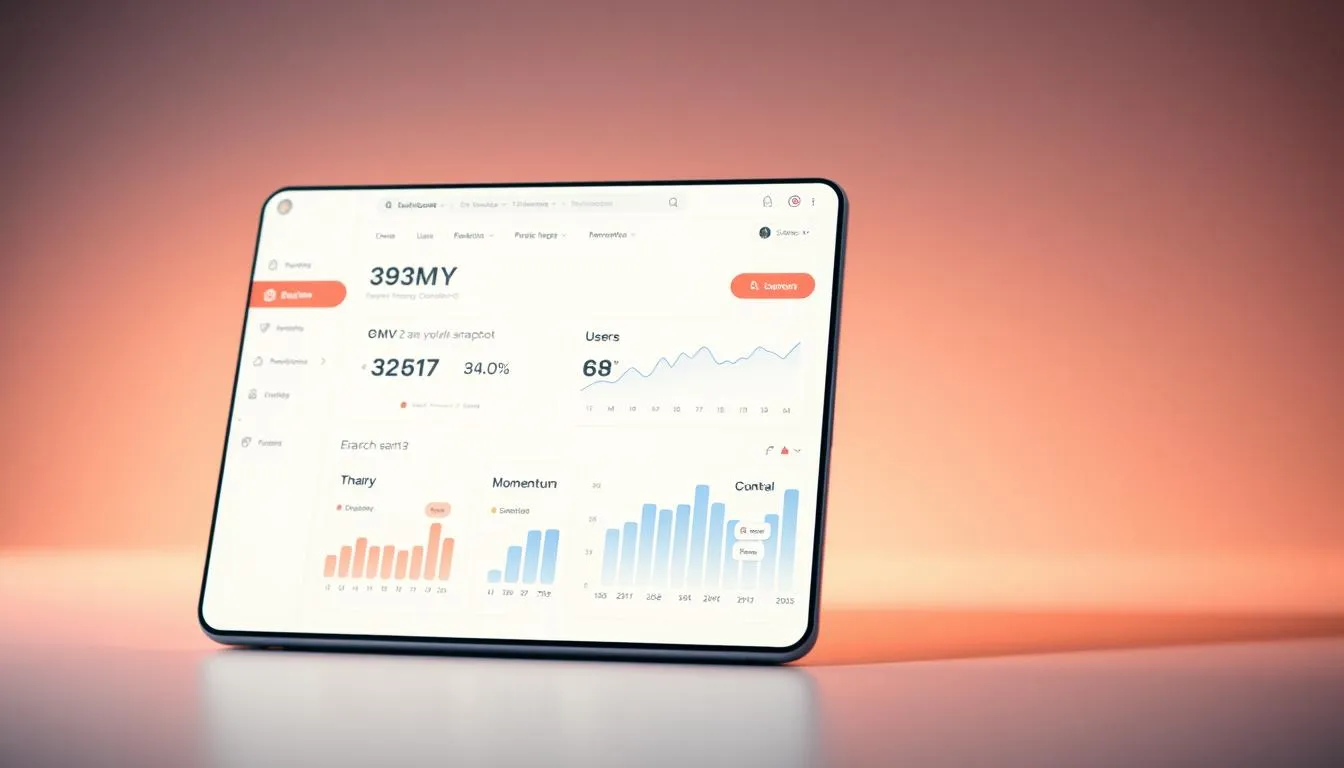Surprising fact: a single fintech from Riyadh now moves nearly $7.5 billion in annualized volume after a recent valuation jump, showing how fast a payments model can scale.
Founded in 2019 by Hosam Arab and Daniil Barkalov, the company built a simple buy-now, pay-later system with four interest-free installments. It added a card, an app, and a cashback program to widen its reach. This model mirrors the growing Klarna usage increase trends seen across global markets.
The platform serves over 15 million registered users and connects with 40,000+ merchants. That scale matters for any U.S. operator studying global market plays today.
This introduction previews a friendly, data-backed take. Well map funding signals, product pillars, and practical levers you can use to translate traction into real strategies for your platform and services.
Key Takeaways
- Benchmarks: tens of millions of users, tens of thousands of merchants, multibillion-dollar volume.
- Product pillars: interest-free installments and a smooth checkout reduce friction.
- Funding momentum signals durability and optionality for partners and integrators.
- Payments platforms can extend into cards, affiliates, and cross-sell opportunities.
- Actionable focus: convert headline metrics into runnable tactics for U.S. teams.
Why Tabby Pay growth matters today for U.S. investors and operators
The surge in digital payments across the region is a practical bellwether for U.S. ecommerce and investors.
Headquartered in Riyadh, Saudi Arabia, this company has scaled rapidly with 15M+ users and 40,000+ merchant partners. Its four-installment, interest-free model reduces checkout friction and cuts cart abandonment.
Why it matters: rising consumer fintech adoption in the middle east shows demand patterns that often precede similar shifts in other markets. U.S. companies can study these signals to prioritize features and UX that lift conversion for discretionary categories.
“High merchant penetration and strong user engagement give investors a useful benchmark for unit economics and underwriting.”

| Signal | Why U.S. teams care | Practical test |
|---|---|---|
| Merchant mix (40k) | Diversifies revenue and smooths seasonality | Run category-specific A/B checkout tests |
| High authorization & lower abandonment | Improves AOV and retention | Integrate BNPL flow in omnichannel checkout |
| Funding & unit-economics | Shifts valuation and investment appetite | Track funding signals via funding signals |
For investors, metrics like GMV trajectory and merchant penetration offer a lens on market durability and potential investment returns. For product teams, the lesson is simple: test the checkout levers that lower friction and measure authorization rates and repeat purchase lifts.
Funding, valuation, and investor confidence behind Tabbys rapid growth
A steady cadence of equity rounds and sizable debt lines underpins the companys push toward an IPO. Successive round milestones and large facilities show how backers underwrite underwriting and operational scale.

From early rounds to a $1.9B capital stack
Equity rounds include Series B checks of $50M and $54M, a $58M Series C, a $250M Series D and a $160M Series E. Debt facilities total over $700M, with earlier $150M and $350M lines.
Valuation jump and public-market signaling
Valuation climbed from 1.5 billion at Series D to 3.3 billion at Series E. That step reflects improved unit economics, faster feature rollout, and positioning ahead of an IPO on the Saudi Exchange.
Whos backing the rounds and why it matters
Key investors include Blue Pool Capital, HIC, STV, Wellington, and Partners for Growth. Their participation mixes public-market expertise, regional alignment, and debt structuring know-how.
| Capital type | Typical use | Strategic signal |
|---|---|---|
| Equity rounds | Product bets, M&A, hiring | Investor conviction in valuation |
| Structured debt | Fund receivables, merchant settlement | Scale without heavy dilution |
| Large facilities | Seasonal liquidity and throughput | Operational resilience at peak volume |
What this means for operators and investors: expect faster feature velocity and geographic expansion while tracking cohort quality, charge-offs, and funding costs as the next valuation drivers.
The current growth snapshot: GMV, users, merchants, and momentum
Current figures point to substantial market traction: wide merchant reach paired with high user engagement. That mix creates a clear network effect for checkout and merchant ROI.

Scale at a glance
Headline metrics: the platform reports 15M+ registered customers, more than 40,000 merchant partners, and an annualized GMV near $10B.
Applying a conservative 25 percent haircut offers a practical baseline. That puts 2024 run-rate GMV closer to ~$7.5B, which helps temper optimism with realistic performance details.
Outpacing global peers
Termsheet Research shows roughly 67 percent 2024 growth faster than some Western peers. For context, that pace outstrips Zips estimated volume and exceeds peers reporting ~30 percent growth.
- Millions of customers and tens of thousands of merchants drive higher authorization rates and repeat orders.
- Merchant breadth across categories smooths seasonality and improves cohort health.
- App engagement MAUs and click-throughs magnifies top-of-funnel demand and merchant ROI.
What matters next: track GMV per active customer, merchant penetration in top categories, and unit economics like loss rates and funding costs. Those signals show whether rapid growth converts into durable scale.
Product engine of growth: BNPL, interest-free payments, and adjacent services
A product suite built around flexible checkout nudges customers to buy now and return often. The core idea is simple: lower friction at checkout so more shoppers complete orders and come back for more.
Core BNPL value
The BNPL service lets customers split purchases into four interest-free payments or choose a deferred, 14-day option. That choice reduces cart abandonment and raises conversion, especially for discretionary shopping.
Card and app reach
The tabby card extends buy-now, pay-later utility into physical stores and broader ecommerce. Meanwhile, the tabby app surfaces deals and drives discovery that funnels buyers back to merchants.
Monetization and levers
Merchants typically pay commissions (roughly 36%), which can be justified by higher average order values and better authorization rates. Late fees exist but form a smaller revenue slice compared with merchant fees and affiliate performance.
- Service stack: risk models, fraud controls, and instant decisions keep approvals fast and reduce merchant friction.
- Tabby Plus: a subscription that lifts LTV via higher limits, exclusive deals, and priority support.
- Feedback loops: richer data refines underwriting and personalizes offers to encourage responsible repeat use.
| Feature | Primary benefit | Operator test |
|---|---|---|
| Four-installment option | Lower abandonment | Measure conversion lift by category |
| App discovery | Incremental traffic | Track referral AOV and affiliate ROI |
| Card integration | Cross-channel usage | Compare in-store vs. online activation rates |
Takeaway: combine financing, discovery, and loyalty to build a stronger marketplace moat. Operators should test bundled feature sets that link product, app, and shopping incentives to boost retention on both sides of the marketplace.
MENA and Saudi Arabia tailwinds: why the region fuels Tabbys scale
National modernization plans are reshaping how people pay, opening room for fast-moving fintech services.
Vision 2030, cashless push, and Tweeq acquisition: infrastructure for payments growth
Vision 2030 accelerates digital adoption across saudi arabia. Public programs push merchants and consumers to prefer digital wallets, cards, and instant settlement.
The acquisition of Tweeq strengthens rails and digital accounts. This acquisition reduces third-party dependence and improves control over customer experiences.
Institutional investment from local backers like HIC signals policy alignment and long-term capital support. That makes it easier for fintech companies to scale with compliance in place.
- Young, mobile-first consumers in the middle east favor flexible checkout and app-driven discovery.
- Cross-border merchant networks speed category expansion across the region.
- Local servicescards and walletscut friction and improve approval rates.
“Public policy and private capital together create a runway for responsible fintech scale.”
| Driver | Result | Operator action |
|---|---|---|
| Vision 2030 | Higher cashless adoption | Prioritize mobile-first UX |
| Tweeq acquisition | Better account rails | Integrate digital accounts |
| Institutional investment | Regulatory alignment | Invest in compliance & data residency |
U.S. operators should watch for partnership opportunities and localized product tests. For context on funding and IPO signals, see the Series E IPO speculation.
Tabby Pay growth versus Western BNPL leaders
Benchmarking volume and momentum across BNPL businesses reveals practical lessons for merchants.
Benchmarking GMV and growth
Headline comparison: the platform reports an annualized GMV near $10B, with a 25% haircut to about $7.5B for 2024. That exceeds Zips ~$6.4B and posts ~67% 2024 growth versus peers like Affirm at ~30%.
| Company | 2024 GMV (approx) | 2024 growth % |
|---|---|---|
| Like tabby (regional) | $7.5B | 67% |
| Zip | $6.4B | ~3035% |
| Affirm / Klarna / Afterpay | Varies by company | ~3050% |
Ecommerce impact: merchant ROI and KPIs
BNPL reduces cart abandonment and lifts average order values. Merchants report higher authorization rates and repeat purchases, similar to patterns observed in Afterpay budgeting trends in the US.
Investors look at cohorts, loss rates, and funding costs to judge resilience behind headline numbers. Operators should track percent-based improvements in conversion, approval, and repeat buys to measure true revenue impact.
“A platform approach consumer app plus merchant tools drives discovery, not just checkout financing.”
Risks, regulation, and resilience in a fast-scaling BNPL model
When a fintech scales quickly, credit performance and compliance risks rise alongside transaction counts. Leaders must balance rapid user acquisition with durable unit economics and clear consumer protections.
Credit, fraud, and compliance: balancing rapid expansion with healthy unit economics
Credit performance is a core vector. Higher volumes can mask rising loss rates if underwriting stays static.
Fraud prevention must evolve in real time. Automated controls, manual review thresholds, and faster dispute flows lower merchant friction.
Compliance obligations scale too. Regulators in the region will expect clearer disclosures and complaint handling as services expand.
What to watch next: funding markets, IPO timing, and regional competition
Facility costs and the availability of debt affect margins. A large $700M facility led by J.P. Morgan helps liquidity, but market shifts can change the effective cost of capital fast.
Investors will study loss rates, recoveries, and cohort durability, not just the gross amount of GMV processed. Transparent reporting builds trust and eases IPO readiness on the Saudi Exchange.
| Risk vector | Why it matters | Resilience play |
|---|---|---|
| Credit performance | Impacts net yield and reserves | Dynamic underwriting and caps |
| Fraud & disputes | Harms merchant relations | Faster resolution SLA and fraud scoring |
| Funding sensitivity | Compresses margins when costs rise | Diversify funding and maintain runway buffers |
| Regulatory scrutiny | Can lead to fines or product limits | Clear disclosures and compliance audits |
A seasoned ceo can set the tone on governance, audits, and responsible expansion. Conservative limits, category diversification, and contingency planning keep services resilient during cycles.
Actionable playbook: how companies can leverage Tabbys platform to grow revenue
Focus on quick wins that use app signals and checkout nudges to lift conversion and average order value. Start with simple tests that tie placement, personalized limits, and clear messaging to KPIs.
Optimize checkout and marketing
Add clear pay later prompts across product pages, cart, and checkout to reduce friction. Use both the four-installment and the pay-in-14-days options where they fit the basket size, following the success of Affirm loans popularity in America.
Personalize suggested limits for returning customers. That raises acceptance while keeping risk managed over time.
Bundle products and solutions like free returns or warranties to lift AOV and revenue per visit.
Data-driven partnerships
Treat the tabby app as an acquisition channel. Negotiate featured slots and time campaigns to peak shopping windows. The app drives millions of monthly sessions and 5M+ outbound clicks, so align promotions with category demand.
- Use first-party app signals to target high-intent customers and send timely reminders.
- Co-create seasonally themed lookbooks to improve discovery and basket size.
- Pilot in-store QR flows to extend payment options at the point of sale.
| Action | Metric | Why it matters |
|---|---|---|
| Checkout prompts | Conversion rate, AOV | Reduces abandonment and lifts revenue |
| App placements | Clicks, approval rate | Drives high-intent traffic and repeat customers |
| Bundled offers | Take rate, LTV | Increases merchant yield with low friction |
Iterate quickly with merchants: align compensation to outcomes, measure approval rate, AOV, and repeat customers, and test Tabby Plus to reward loyal segments while watching LTV and support load.
Conclusion
Strong execution from leadership has pushed the business from early market fit to a durable, investable platform.
Hosam Arab and the executive team scaled the company through disciplined rounds and large facilities, lifting valuation from 1.5 billion to 3.3 billion while signing millions of customers and thousands of merchants.
What to copy: simple, interest-free payments, clear terms, and in-app discovery that turns visits into repeat shopping. Use the tabby app and tabby card as examples for embedding offers at the right time.
Measure percent lifts in conversion, AOV, and repeat buys. Audit checkout this week, prioritize two quick wins, and schedule a partnership pilot if early signals look strong.
FAQ
What makes this buy-now-pay-later companys expansion important for U.S. investors and operators?
The region’s fast consumer digitization and rising ecommerce create a large addressable market. For U.S. investors, the firms execution across merchants, users, and payment rails shows scalable unit economics and cross-border growth potential. Operators can learn tactics to lift conversion, average order value, and repeat purchase rates by adapting proven checkout and marketing plays.
How was the recent funding raised and what does the capital structure look like?
The company completed multiple rounds from institutional backers, building a capital stack that includes over $1.9 billion in equity tranches plus more than $700 million in debt facilities. That mix supports rapid expansion, product development, and merchant acquisition without immediate profitability pressure.
What valuation milestones has the fintech achieved and what do they signal?
Valuation climbed from roughly $1.5 billion at a prior late round to about $3.3 billion in the latest round. Those steps indicate investor confidence in market leadership, potential public market readiness, and the ability to sustain scale across the MENA region and GCC markets.
Who are the major backers driving this companys expansion?
A mix of regional and global investors has supported the firm, including institutional growth funds, sovereign-linked investors, and specialist fintech VCs. Notable names on cap tables include Blue Pool Capital, HIC, STV, Wellington, and Partners for Growth, providing strategic capital and market connections.
What does the current operational footprint look like in terms of users, merchants, and GMV?
The platform serves millions of customers and tens of thousands of merchants, demonstrating broad acceptance. Annualized gross merchandise value has reached multibillion levels, reflecting strong transaction frequency and merchant adoption across ecommerce categories.
How does its scale compare to Western BNPL rivals?
While market dynamics differ, the company has matched or exceeded some peers on regional growth percentage and GMV trajectories. Benchmarking shows faster user adoption in targeted markets, driven by high mobile penetration, localized product features, and merchant partnerships.
What core products drive customer engagement and merchant revenue?
The primary offering splits purchase amounts into four interestfree installments, which improves affordability and conversion. Complementary products include a card for instore and online use, a premium subscription tier with perks, and merchant tools for promotions and analytics that boost monetization.
How does the payments ecosystem in Saudi Arabia and wider MENA support scaling?
Local reforms like Saudi Vision 2030 and a push toward cashless transactions created fertile ground. Infrastructure upgrades, rising card acceptance, and strategic acquisitions have accelerated merchant onboarding and consumer trust, helping the business scale quickly.
What regulatory and credit risks should stakeholders watch?
Key risks include evolving consumer credit rules, stricter compliance expectations, and credit loss from macro shocks. The firm manages these with underwriting models, fraud detection, and capital buffers, but ongoing regulatory developments in the region remain an important variable.
What growth levers can merchants and partners use with this platform?
Merchants can optimize checkout placement, highlight installment options in marketing, and personalize limits to increase conversions. Data partnerships and integration with the companys app and loyalty programs help target highintent shoppers and lift lifetime value.
How does monetization work beyond merchant commissions?
Revenue streams include merchant fees, affiliate partnerships, subscription upgrades, incidental late fees, and valueadded services such as analytics. Diversifying income helps reduce reliance on any single source while improving overall margins.
Could an initial public offering be on the horizon and what would that mean?
With higher valuations and strong capital backing, public markets are a plausible next step. An IPO would validate the regional fintech narrative, provide liquidity for investors, and offer more capital for international expansionwhile increasing regulatory scrutiny and disclosure requirements.
